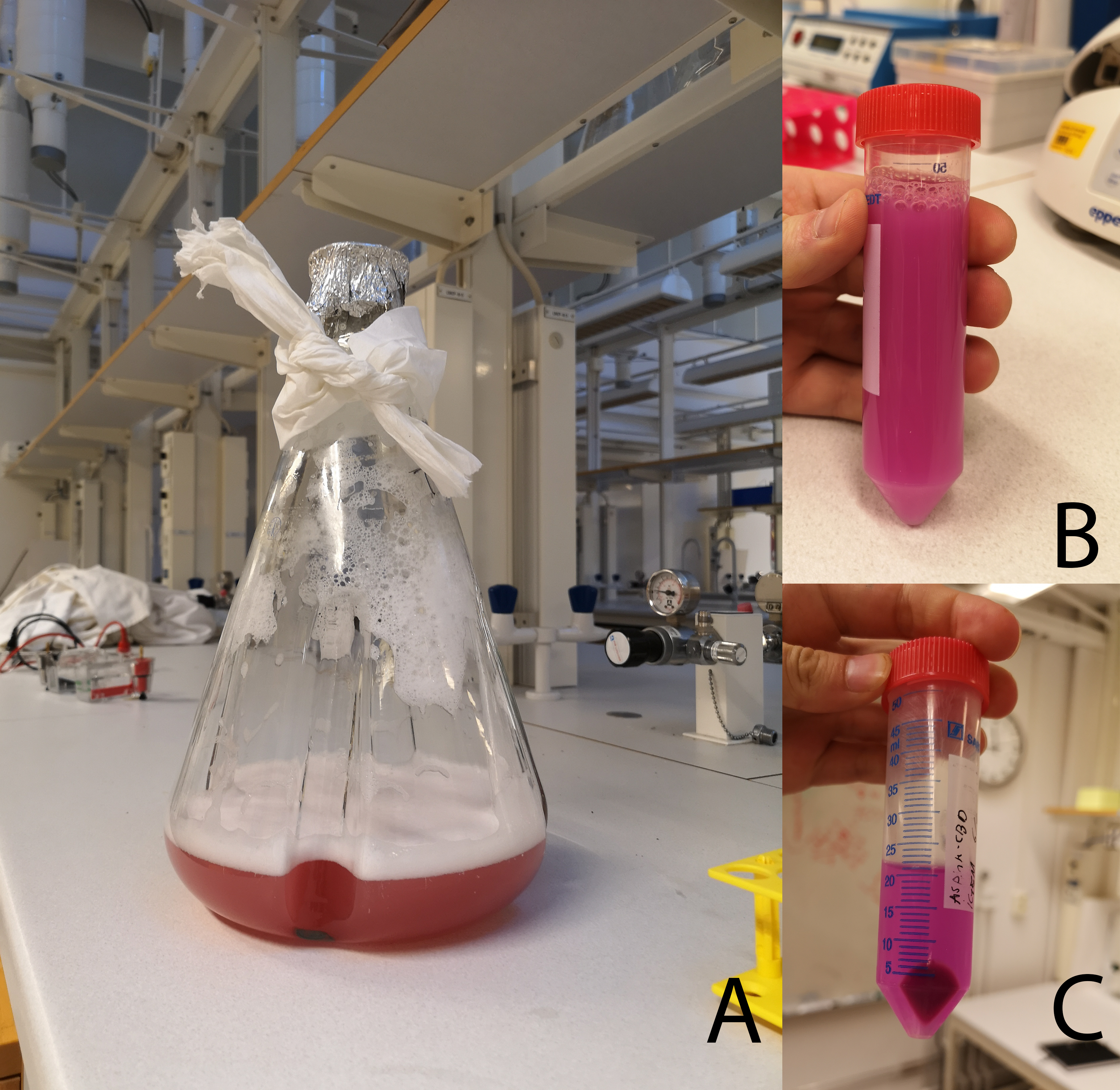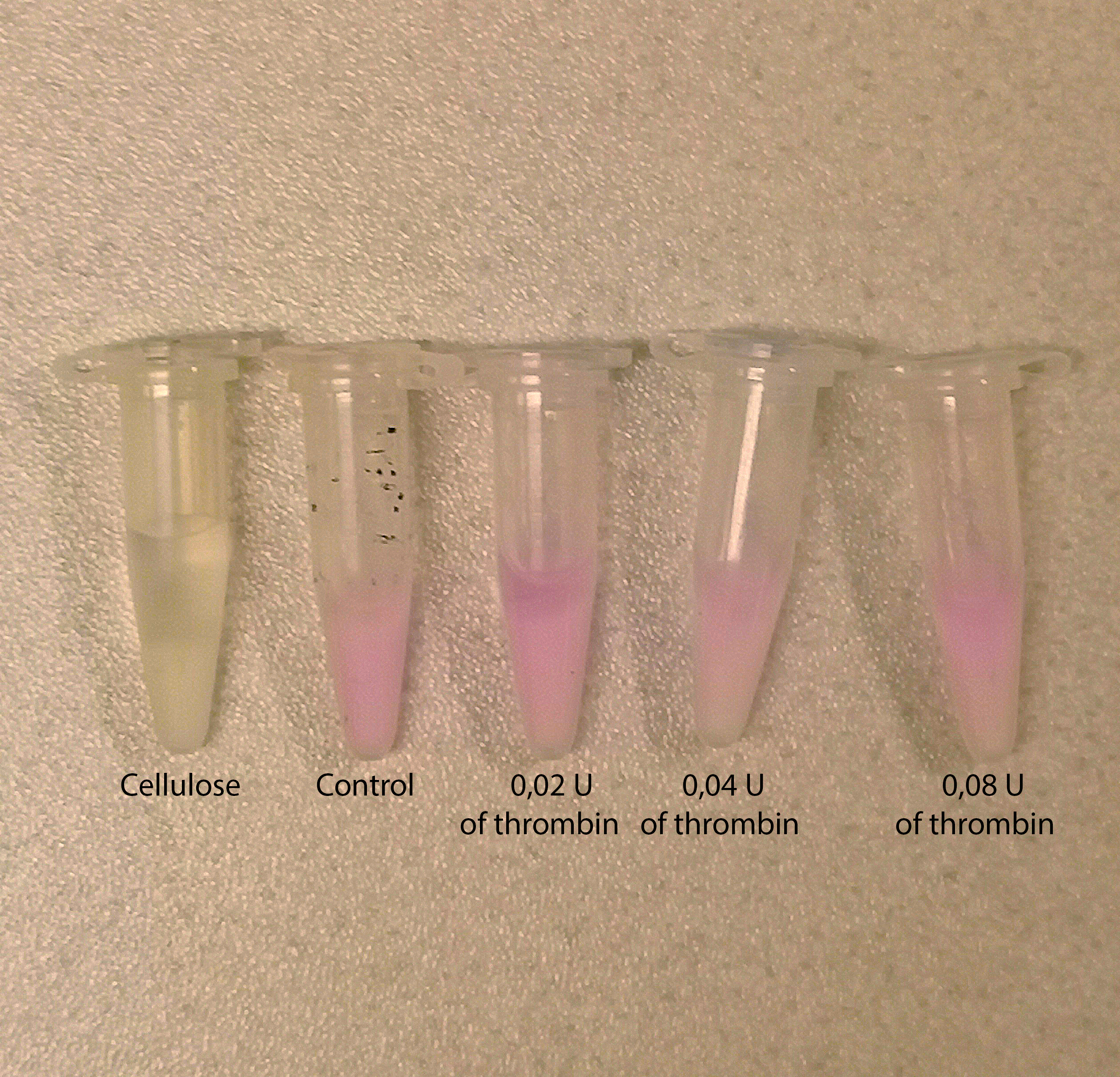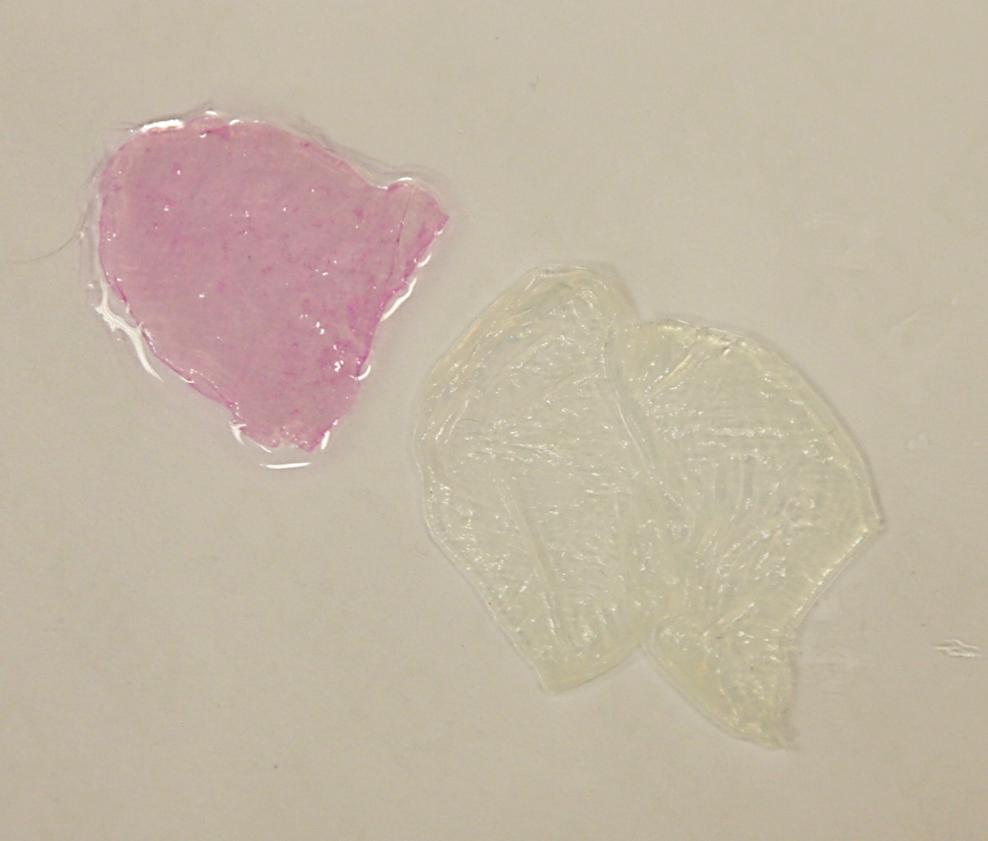Part:BBa_K3182000
Sequence and Features
- 10COMPATIBLE WITH RFC[10]
- 12COMPATIBLE WITH RFC[12]
- 21INCOMPATIBLE WITH RFC[21]Illegal BamHI site found at 580
- 23COMPATIBLE WITH RFC[23]
- 25COMPATIBLE WITH RFC[25]
- 1000COMPATIBLE WITH RFC[1000]
Introduction
pT7-CBDcipA-AsPink

This part consists of a carbohydrate binding domain (CBD) from Clostridium thermocellum (C. thermocellum) cellulose scaffolding protein (CipA). This binding domain is a central part of Clostridium thermocellum's cellusome and has a strong affinity for cellulose. The CBD was fused to another protein using a flexible GS-linker (-GGGGSGGGGS-)in order to attach this complex to a polysaccaride material. A thrombin cleavage site (-LVPRGS-) was added to the end of the linker and its breakage will leave a glycine and serine attached to the N-terminal of the fusion protein. The main mechanism of iGEM19 Linköping's project can be seen in Figure 1.
Protease site and use
The thrombin site was added to enable the ability to release the fusion protein down into skin wounds. Thanks to our integrated human practice we learned that infections span much deeper into wounds that we thought. Simply attaching the CBD-fusion protein to a carbohydrate material would not enable the fusion protein to reach far into the wound. The thrombin site was also chosen because of thrombin's endogenous existence in humans.
Assembly compabilities
An internal BamHI recognition sequence (RS) has been added to enable interchangeable fusion proteins to the CBD. BamHI was chosen because its RS codes for glycine and serine, fitting it to the end of the thrombin site. It is also a cost-effective enzyme and is unaffected by methylated DNA. BamHI is a part of the RFC21 standard.
CBDcipA crystal structure
Important molecular faces
CBDcipA is composed of a nine-stranded beta sandwich with a jelly roll topology and binds a calcium ion, which can be seen in Figure 2. It further contains conserved residues exposed on the surface which map into two clear surfaces on each side of the molecule. One of the faces mainly contains planar strips of aromatic and polar residues which may be the carbohydrate binding part. Further aspects are unknown and unique to this CBD such as the other conserved residues which are contained in a groove.
Carbohydrate binding domain specificity
Since the CBD is from the cellusome of C. thermocellum some research labeled it a cellulose binding domain. However, iGEM19 Linköping noticed that this domain could also bind to different sources of polysaccaride materials. This serves as a domain for iGEM19 Linköpings modular bandage, where the polysaccaride material can be exchanged for other/similar materials and not exclusively cellulose.
The choice of carbohydrate binding domain
iGEM Linköping 2019 chose CBDcipA due to the fact that many other iGEM teams had explored the possibilities of this domain. Our basic design was influenced by [http://2014.igem.org/Team:Imperial iGEM14 Imperial], [http://2015.igem.org/Team:edinburgh iGEM15 Edinburgh] and [http://2018.igem.org/Team:ecuador iGEM18 Ecuador]. Purification and where to place the fusion protein (N- or C-terminal) was determined by studying the former projects. CBDcipA also originates from a thermophilic bacteria which further increases the domain's applications.
Expression system
The part has a very strong expression with a T7-RNA-polymerase promotor (BBa_I719005), seen in Figure 3, as well as a 5'-UTR (BBa_K1758100) region which has been shown to further increase expression in Escherichia coli (E. coli) (BBa_K1758106), ([http://www.ncbi.nlm.nih.gov/pubmed/2676996 Olins et al. 1989]), ([http://www.ncbi.nlm.nih.gov/pubmed/23927491 Takahashi et al. 2013]).

Usage and Biology

A pink colony from an agar plate was selected and cultured in 10 mL LB-miller for 16 h at 37 °C, 180 rpm. This culture was afterwards added to 1 L of LB-miller containing appropriate antibiotics which was grown for 16 h, 80 rpm at 16 °C. This result can be observed in figure 4. Approximately 45 mL of the culture was poured to a 50 mL Falcon tube and sonicated which is displayed in figure 5. A 50 mL Falcon tube was later filled and centrifuged a pink pellet was formed (seen in figure 6).
AsPink bound to cellulose bandage
Epiprotect® (microbial cellulose bandage, S2Medical) was incubated in AsPink lysate from BL21 (DE3) Gold for 30 min. Epiprotect® was later washed with 70 % ethanol three times. To the left is AsPink incubated Epiprotect® and to the right is plain Epiprotect®.
Thrombin Cleavage
In figure 9 bacterial lysate of sonicated E. coli BL21 (DE3) was incubated with cellulose (Whatman CF-11 Fibrous Medium Cellulose Powder) for 1 h on an end-to-end rotator at R.T. The cellulose was saturated with AsPink lysate. The samples were afterwards centriuged at 3000 g in 1 min and the supernatant was removed. In all samples cleavage buffer (20 mM Tris-HCl pH 8.4, 150 mM NaCl and 2.5 mM CaCl₂) was added and three different dilutions of thrombin (Novagen) were added. The dilutions were 0.02, 9.94 and 0.08 units (U). One unit refers to the amount of thrombin needed to cleave 1 mg of protein for 16 h at R.T. in a 200 µL reaction containing the cleavage buffer. The samples were put on an end-to-end rotator overnight (ca 16 h) and left at R.T. The control with only cleavage buffer has a transparent supernatant and a pink pellet of cellulose. The most diluted (0.02 U) has a slightly pinker supernatant and less pink pellet, however the 0.04 U and 0.08 U dilutions have a pinker supernatant and more pale pellet, with 0.08 U dilution being the sample with the most cleaved AsPink displayed by the more intense supernatant.

| None |


